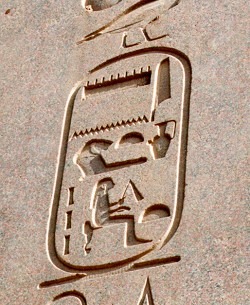
Bezeichnung für die elliptische Linie, die die Ägypter um zwei der Namen des Königs von der 4. Dynastie an zogen, um seinen Geburtsnamen ('Sohn des Re'-Name) und um seinen Thronnamen ('König von Oberägypten und Unterägypten'-Name). Detaillierte Darstellungen zeigen deutlich, daß die Kartuschenlinie aus einer (doppelten) Schnur besteht, die an einem Ende geknotet ist. Die Form der Kartusche entwickelte sich aus dem runden 'Schen' oder Ring der Ewigkeit/Unendlichkeit; je länger der Königsname wurde, desto mehr dehnte sich der Ring in die Länge. Die Bedeutung der Kartusche war 'Schutz durch Umkreisung', wobei der Name des Königs für die Welt stand, die von der Sonne umkreist wurde. Einige Sarkophage des Neuen Reiches und die Grabkammern einiger Gräber im Tal der Könige, etwa jene Thutmosis' III., sind ebenfalls wie eine Kartusche geformt (die manchmal auf dem Deckel dargestellt ist), so daß der König darin, wie sein Name, von der Kartusche umgeben war. Bei der Entzifferung der Hieroglyphen waren die Kartuschen eine große Hilfe, da man vermutete, daß die Zeichen in einer Kartusche den Namen des Königs darstellten. Champollion beispielsweise versuchte, auf Manetho basierend die Kartuschen in eine richtige Reihenfolge zu bringen. Die französische Bezeichnung wurde von den napoleonischen Soldaten eingeführt, die fanden, daß sie dieselbe Form hätten wie ihre Gewehrpatronen, die cartouches hießen. Mittlerweile hat sich der Begriff in der Ägyptologie durchgesetzt.